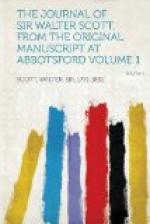I dined quietly at home with the girls, and wrote after dinner.
January 17.—Nothing in the roll; corrected proofs, and went off at 12 o’clock in the Hamilton stage to William Lockhart’s at Auchinrath. My companions, Mr. Livingstone, the clergyman of Camnethan, a Bailie Hamilton, the king of trumps, I am told, in the Burgh of Hamilton, and a Mr. Davie Martin qui gaudet equis et canibus. Got to Auchinrath by six, and met Lord Douglas,[237] his brother, Captain Douglas, E.N., John G-. Lockhart also, who had a large communication from Duke of W. upon the subject of the bullion. The Duke scouts the economist’s ideas about paper credit, after the proposition that all men shall be entitled to require gold.
January 18.—We went, the two Lockharts and I, to William’s new purchase of Milton. We found on his ground a cottage, where a man called Greenshields,[238] a sensible, powerful-minded person, had at twenty-eight (rather too late a week)[239] taken up the art of sculpture. He had disposed of the person of the King most admirably, according to my poor thoughts, and had attained a wonderful expression of ease and majesty at the same time. He was desirous of engaging on Burns’ Jolly Beggars, which I dissuaded. Caricature is not the object of sculpture.
We went to Milton on as fine a day as could consist with snow on the ground. The situation is eminently beautiful; a fine promontory round which the Clyde makes a magnificent bend. We fixed on a situation where the sitting-room should command the upper view, and, with an ornamental garden, I think it may be made the prettiest place in Scotland.
January 19.—Posted to Edinburgh with John Lockhart. We stopped at Allanton to see a tree transplanted, which was performed with great ease. Sir Henry is a sad coxcomb, and lifted beyond the solid earth by the effect of his book’s success. But the book well deserves it.[240] He is in practice particularly anxious to keep the roots of the tree near the surface, and only covers them with about a foot of earth.




